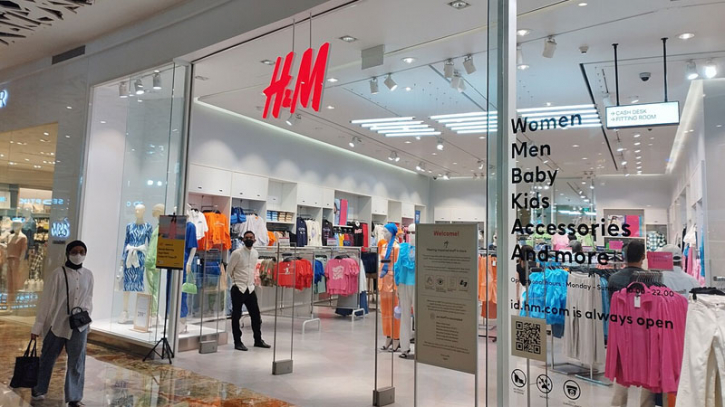H&M exits Myanmar leaving survival of 42,000 workers uncertain

Workers in the Myanmar factories that supply global brand H&M—most of whom are women—are worried about how they will survive after the fast-fashion Swedish titan announced on Thursday that it would phase out the South-east Asian country.
The world’s second-largest fashion retailer sources directly from 41 factories in junta-controlled
Myanmar and as of March 2023 it employed almost 42,000 workers at these factories, according to its website. The factories that it directly sources from also outsource some of their work to other factories, H&M says on its website, but it does not disclose their names, number, or the number of workers these factories employ, Irrawaddy reports.
A 32-year-old worker at H&M supplier Saung Oo Shwe Nay (Golden Sunshine) Co Ltd in Yangon’s Hlaing Thar Yar Township said her job provides her family with its only regular source of income.
She fears losing her job because her husband—a day laborer on construction sites—does not have full-time work. “He doesn’t get money daily and we have to feed my mom and our six-year-old daughter. So, I can’t lose this job at this moment,” she said.
Her fear is echoing throughout factories that supply H&M, workers and others say.
Vicky Bowman, the director of the Myanmar Centre for Responsible Business and a former British ambassador to Myanmar, told Reuters: “I regret H&M’s announcement, as it will have a negative impact on thousands of women workers in Myanmar.”
H&M’s announcement followed by one day the release of the report “Falling out of fashion: Garment worker abuse under military rule in Myanmar” by the UK-based Business and Human Rights Resource Centre.
The rights group had earlier launched its “Myanmar garment worker allegations tracker” after receiving an increase of reports of abuses at factories in Myanmar after the February 2021 coup. Subsequent research found severe violations of human rights in the supply chains of global brands sourcing from Myanmar.
“Wage theft, unfair dismissal and inhumane work rates, and mandatory overtime are the most frequently recorded types of abuse. Cases also include killings, arrest and arbitrary detention of workers by the military, gender-based violence, attacks on freedom of association, harassment and child labor,” it said.
The rights group tracked 156 cases of alleged abuse in Myanmar garment factories from February 2022 to February 2023, and linked them to global brands including Inditex-owned Zara, Primark, Bestseller, C&A and Mango.
Twenty of the cases were linked to H&M and another 20 were linked to Spain-based Inditex, whose main brand is Zara. Inditex announced in late July that it was exiting Myanmar.
A consultant who works for a labor rights watchdog in Myanmar said it was possible that the factories that now supply H&M may find other buyers.
“The supplier factories of H&M in Myanmar may not shut down at once. They could try to get offers from other brands from other countries. However … the workers will have to suffer reductions of salaries for example, or some of them may get laid off.”
Workers producing the H&M brand in Myanmar—and other countries—have been unfairly fired, harassed, intimidated, abused and experienced gender-based violence, labor and rights groups have reported repeatedly.
Reports of abuse in post-coup Myanmar, however, have been too much to handle for many global brands.
In September 2022, workers at Saung Oo Shwe Nay garment factory were forced to walk on their knees for falling short of the production quota set by the factory owner, according to “Falling out of fashion: Garment worker abuse under military rule in Myanmar.”
In August 2022, workers at H&M supplier Myanmar Jiale Fashion Garment Factory reported pregnancy discrimination, including alleged absence of pregnancy leave and dismissal.
In November 2021, 86 workers from Mingalar Sumbiri Garment Factory— which supplies European brand C&A and H&M—were dismissed with reduced compensation.
H&M is the latest to cut ties with suppliers in Myanmar, following the beginning of an exodus of western brands last year, including Primark and Marks & Spencer, as pressure mounted due to widespread reports of systemic and extreme abuse inside Myanmar’s garment factories.
For Myanmar, however, the garment sector is a vital employer, especially for women. Reports estimate that 90 percent of the workers at the more than 500 factories in Myanmar are women.
Myanmar’s fall from fashion will hurt its workers most.
Even the Business and Human Rights Resource Centre said that garment workers who lose their jobs are more eager to find new ones than they are to receive compensation. “It is very difficult to find new jobs in Myanmar,” it quoted one worker as saying. ” There is a family behind every factory worker,” she said.
A director of a labor rights organization based in Hlaing Thar Yar Township told The Irrawaddy that they are now very concerned about the likelihood of workers finding jobs. The exit of global brands—whose profitability is based on their brand image—will leave workers dependent on buyers who care less about how women in developing countries are treated.
Bowman agreed, saying: “If they leave, either the jobs disappear entirely, or factories scrabble to receive orders from footloose buying agents who care only about cheap labor and do not worry about factory conditions.”
“The factory owners [are] mostly the Chinese [and they] tend to bear a grudge against workers if they have encountered losses … As a result, workers will soon face more pressure, discrimination, and other hardships,” the director of the rights organization said.
He called on the global brands to withdraw from Myanmar responsibly, and to follow guidelines set by international labor rights organizations. Their withdrawal from Myanmar will be closely monitored, and the rights of workers will continue to be monitored even after they complete their exit, he said.
.png)




